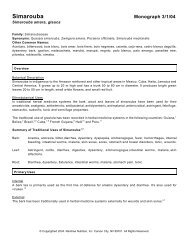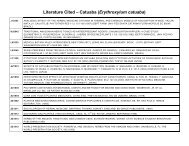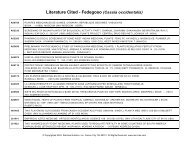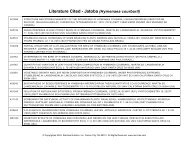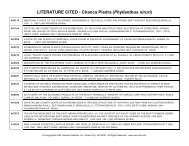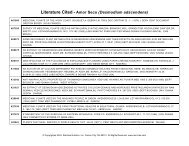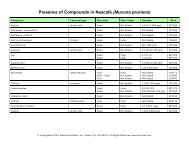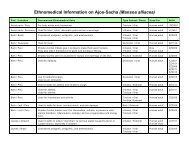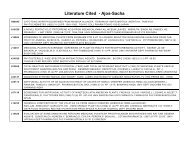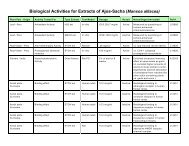Organ Specific Guide - Raintree Nutrition, Inc
Organ Specific Guide - Raintree Nutrition, Inc
Organ Specific Guide - Raintree Nutrition, Inc
You also want an ePaper? Increase the reach of your titles
YUMPU automatically turns print PDFs into web optimized ePapers that Google loves.
AJOS SACHA CAPSULES<br />
Description: Ajos sacha is an evergreen tropical shrubby vine that is native to the Amazon rainforest. Its<br />
Spanish name, ajos sacha, means "false garlic" and refers to the strong garlic smell and flavor of the<br />
leaves when crushed. Ajos sacha contains some of the same active plant chemicals found in regular<br />
garlic.This plant is referred to by two botanical names: Mansoa alliacea and Adenocalymma alliaceum.<br />
Traditional uses by organ or system: Musculoskeletal: For arthritis and rheumatism, as a general<br />
analgesic (muscles, joints, body aches), and for general inflammation (external and internal).<br />
Ingredients: 100% pure ajos sacha leaves (Mansoa alliacea).<br />
Suggested Use: Take 2 capsules 2-3 times daily or as needed.<br />
Contraindications: None reported.<br />
Drug Interactions: None reported.<br />
Other Practitioner Observations and Possible Precautions: None.<br />
Synopsis of research: (Please the online Tropical Plant Database for Ajos Sacha for all cited<br />
research.)<br />
In Peru and Brazil, ajos sacha is considered analgesic, anti-inflammatory, and antirheumatic and widely<br />
used for arthritis, rheumatism, body aches and pain, and muscle aches, injuries and pain.<br />
In research published in 1980, a water extract of ajos sacha leaves was reported to have an antioxidant<br />
effect which was attributed to the anthocyanin compounds found in the plant. Researchers confirmed ajos<br />
sacha's long standing use for arthritis and rheumatism when they reported that the plant was capable of<br />
inhibiting COX and well as reduced ear edema in a study with rats in 1997.<br />
Other research has reported that ajos sacha can lower cholesterol much like garlic does. It has also been<br />
reported with antimicrobial actions against fungi, plant viruses, and bacteria, which may help explain its<br />
other long standing uses for colds, flu, pneumonia and other upper respiratory infections.<br />
Anti-inflammatory Actions:<br />
Dunstan, C. A., et al. "Evaluation of some Samoan and Peruvian medicinal plants by prostaglandin biosynthesis and<br />
rat ear oedema assays." J. Ethnopharmacol. 1997; 57: 35-56.<br />
Antioxidant Actions:<br />
Scogin, R. "Anthocyanins of the Bignoniaceae." Biochem. Syst. Ecol. 1980; 273-276.<br />
Desmarchelier, C., et al. "Total reactive antioxidant potential (TRAP) and total antioxidant reactivity (TAR) of medicinal<br />
plants used in Southwest Amazona (Bolivia and Peru)." Int. J. Pharmacog. 1997; 35(4): 288-296.<br />
Cholesterol-Lowering Actions:<br />
Yeh, Y. Y., et al. "Cholesterol-lowering effect of garlic extracts and organosulfur compounds: human and animal<br />
studies." J. Nutr. 2001 Mar; 131(3s): 989S-993S.<br />
Srinivasan, M. R., et al., "Hypocholesterolemic efficacy of garlic-smelling flower Adenocalymma alliaceum Miers. in<br />
experimental rats." Indian J. Exp. Biol. 1995; 33(1): 64-66.<br />
Antimicrobial Actions:<br />
Rana, B. K., et al. "Antifungal activity of an aqueous extract of leaves of garlic creeper (Adenocaymma alliaceum<br />
Miers.)." Pharmaceutical Biol. 1999; 37(1): 13-16.<br />
Singh, U. P., et al. "A rapid method for detecting fungi-toxic substances." World Journal of Microbiology and<br />
Biotechnology. 1996; 12(3): 301-302.<br />
Khurana, S., et al. "Effect of plant extracts on the activity of three papaya viruses." J. Gen. Appl. Microbiol. 1970; 16:<br />
225-230.<br />
Ushamalini, C., et al. "Management of charcoal rot of cowpea using biocontrol agents and plant products." Indian<br />
Phytopathol. 1997; 50(4): 504-507.<br />
Canapaty, S., et al. "Composition of leaf oil from Adenocalymma alliaceum and its antimicrobial activity." Indian<br />
Perfumer. 2004; 48(3): 323-329.<br />
Rao, A. M., et al. "Antimicrobial activity of the leaf extract of Adenocalymma alliaceum." Indian Drugs. 1985: 22(7):<br />
364-365.



